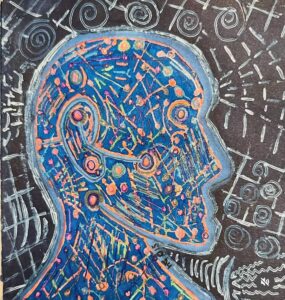Like my colleague Dr. Mary Riley, the culinary arts and metaphors have been a large part of my life. Many times, the metaphor of baking has helped me to make sense of new ideas, learn new concepts, or put my thoughts together more seamlessly. Before we dive any further into the kitchen with EMDR and DBT, let’s explore some introductory information first. For those in need of an orientation, the proceeding paragraphs will give a short explanation of EMDR and DBT. Note, trauma in this context is considered to be a “wound” not necessarily just the big traumas many of us usually identify such as war, a lethal accident/occurrence, or sexual assault/rape.
EMDR therapy is defined by World Health Organization in this manner:
“[EMDR] therapy is based on the idea that negative thoughts, feelings, and behaviors are the result of unprocessed memories. The treatment involves standardized procedures that include focusing on (a) spontaneous associations of traumatic images, thoughts, emotions and bodily sensations and (b) bilateral stimulation that is most commonly in the form of repeated eye movements. Like CBT with a trauma focus, EMDR aims to reduce subjective distress and strengthen adaptive beliefs related to the traumatic event. Unlike CBT with a trauma focus, EMDR does not involve (a) detailed descriptions of the event, (b) direct challenging of beliefs, (c) extended exposure, or (d) homework.” (Marich, 2019).
Regarding DBT, Marsha Linehan the developer of the therapy states:
“Dialectical Behavior Therapy is a broad-based cognitive-behavioral treatment originally developed for chronically suicidal individuals diagnosed with Borderline Personality Disorder (BPD). Consisting of a combination of individual psychotherapy, group skills training, telephone coaching, and a therapist consultation team, DBT was the first psychotherapy shown through controlled studies to be effective with BPD. Since then, multiple clinical trials have been conducted demonstrating the effectiveness of DBT not only for BPD, but also for a wide range of other disorders and problems, including both undercontrol and overcontrol of emotions and associated cognitive and behavioral patterns Furthermore, an increasing number of studies suggest that skills training alone is a promising intervention for a variety of populations…” (Linehan, 2015).
Merging these together, just like chocolate and chili, if we look at the theoretical frameworks alone (cue the eye rolls from us more expressive arts types), EMDR’s AIP model is closely related to DBT’s Biosocial Theory. They both assert:
- Nature and nurture play a role in the development of pathology.
- AKA: stuff you are born with and stuff you interact with (caregivers, certain situations, environments, etc.) can make you end up with problems/issues/diseases.
- This pathology can be traced back to and rooted in traumatic occurrences, memories, and/or development.
- AKA: problems/issues/diseases can be because of wounding or stuff that happened to you.
- Treatment, while still implementing specific procedures or modules, focuses on changing maladaptive interactions between the client and their…
- environments
- relationships
- emotions (emotion dysregulation)
- cognitions
- behaviors
- sensations
- memories
- beliefs (about self and others)
- perceptions
- attitudes
- AKA: getting counseling involves certain things the therapist will walk you through, but mainly focuses on helping you to change the bad or knee-jerk reactions you might have with various things.
- These maladaptive responses can be successfully transformed into adaptive responses in the form of positive information, resources, memories, etc.
- AKA: those bad or knee-jerk reactions can be changed into good or thoughtful reactions (in a whole bunch of ways).
Now that we have our foundational principles in place, let’s bake a cake, shall we? The use of metaphors is frequently implemented in DBT and can help clients understand weightier concepts; just as the baking metaphor has helped me in my life. Let’s put on our aprons and get to work! The 8 Phases of EMDR can be considered the recipe while the application of EMDR is putting the ingredients together to bake. DBT’s role is that of fusion, again, the chili to the chocolate. With this idea of baking, DBT’s modules and skills (ingredients) can easily align with EMDR’s phases (recipe with ingredients). The recipe is as follows:
- Phase 1: History Taking
- DBT: Pretreatment and Determination of Treatment Intensity (DBT Stage 1, 2, 3, or 4 to guide treatment). Utilization of Biosocial Theory, psychoeducation, normalization and validation of emotions/cognitions.
- Phase 2: Preparation
- DBT: Orienting the Client to the Specifics of Skills Training, Teaching the Four Skills Modules.
- Phase 3: Assessment
- DBT: Educating clients that life itself is activating. Review of assigned homework from previous session(s).
- Phase 4: Desensitization
- DBT: Teaching clients to learn how to “ride the waves” of activation with the use of skills.
- Phase 5: Installation
- DBT: Reinforcing skills and conveying to clients the importance of practicing skills.
- Phase 6: Body Scan
- DBT: Mindfulness skills, body-based Distress Tolerance skills, and body-based Emotional Regulation skills.
- Phase 7: Closure
- DBT: Closing Wind-Down and assignment of homework.
- Phase 8: Re-Evaluation
- DBT: Diary Card, Chain-link Analysis, and exploration of what has worked for client verses what hasn’t worked (problem solving strategies).
Voila! A perfectly baked therapy cake with all its yummy fusion goodness! To finish off our baking masterpiece, let’s talk about icing. Icing is what usually draws us to the dessert. Seeing those lovely frothed peaks of icing begging to be eaten, how can we say no? Icing, in this case, can be identified as the “sell” to the client; the explanation of why EMDR and DBT work so great together. In Phase 3 of EMDR, when we are getting the client activated, we can compare this to a raging fire or the extreme temperatures of an oven. When making the “sell” Arbeitman, Goodwin-Brown, and Loomis (2016) give the example that “DBT manages the fires. EMDR Therapy extinguishes the fires.” By educating clients that the fires of life will always be there in one form or another, we give them a choice. They can choose to use those fires and temperatures to bake a cake or choose to have those same fires burn them alive. I’m guessing your clients might want cake instead of ongoing emotional 3rd degree burns. So why not invite them into the kitchen and have them sample how the combination of chocolate and chili might sound odd?
Odd, and yet oh so tasty!
REFERENCES
Arbeitman, D., Goodwin-Brown, R., & Loomis, G. (2016, April). Integrating dialectical behavioral therapy (DBT) and EMDR with suicidal and self-injuring clients. Presentation at the 12th Western Mass Regional Network Spring Conference, Amherst, MA
Koerner, K. (2012). Doing Dialectical Behavior Therapy: A Practical Guide (Guides to Individualized Evidence-Based Treatment). The Guilford Press. New York, NY.
Linehan, M. (1993). Cognitive-Behavioral Treatment of Borderline Personality Disorder.
Linehan, M. (2015). Skills Training Manual for Treating Borderline Personality Disorder. Second Edition.
Marich, J. (2014). Trauma made simple: Competencies in assessment, treatment, and working with survivors. Eau Claire, WI: PESI Publications & Media.
Marich, J. (2019). Eye Movement Desensitization and Reprocessing (EMDR) Therapy: Training Course Part 1 and Training Course Part 2 Manuals. The Institute for Creative Mindfulness 2015. 8th Edition.





One Response
this sounds very interesting. I would love to see some webinars, or training with combining these therapies!